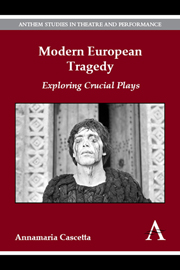Book contents
- Frontmatter
- Dedication
- Contents
- Acknowledgements
- Introduction: The Tragic, Tragedy and the Idea of the Limit
- Chapter 1 Hubris and Guilt: Gengangere (Ghosts)
- Chapter 2 Eve Becomes Mary: L'annonce faite à Marie (The Tidings Brought to Mary)
- Chapter 3 The School of Hatred: Mourning Becomes Electra
- Chapter 4 The Destiny of Man Is Man: Mutter Courage und ihre Kinder (Mother Courage and Her Children)
- Chapter 5 The Tragic and the Absurd: Caligula
- Chapter 6 Dianoetic Laughter in Tragedy: Accepting Finitude: Endgame
- Chapter 7 The Arrogance of Reason and the ‘Disappearance of the Fireflies’: Pilade (Pylades)
- Chapter 8 The Apocalypse of a Civilization: From Akropolis to Apocalypsis cum figuris
- A Provisional Epilogue: Between the Experience and the Representation of the Tragic: Towards a Performative Theatre
- Appendix: Chronology of Productions
- Notes
- Index
Introduction: The Tragic, Tragedy and the Idea of the Limit
Published online by Cambridge University Press: 05 September 2014
- Frontmatter
- Dedication
- Contents
- Acknowledgements
- Introduction: The Tragic, Tragedy and the Idea of the Limit
- Chapter 1 Hubris and Guilt: Gengangere (Ghosts)
- Chapter 2 Eve Becomes Mary: L'annonce faite à Marie (The Tidings Brought to Mary)
- Chapter 3 The School of Hatred: Mourning Becomes Electra
- Chapter 4 The Destiny of Man Is Man: Mutter Courage und ihre Kinder (Mother Courage and Her Children)
- Chapter 5 The Tragic and the Absurd: Caligula
- Chapter 6 Dianoetic Laughter in Tragedy: Accepting Finitude: Endgame
- Chapter 7 The Arrogance of Reason and the ‘Disappearance of the Fireflies’: Pilade (Pylades)
- Chapter 8 The Apocalypse of a Civilization: From Akropolis to Apocalypsis cum figuris
- A Provisional Epilogue: Between the Experience and the Representation of the Tragic: Towards a Performative Theatre
- Appendix: Chronology of Productions
- Notes
- Index
Summary
Relevance of the Tragic, Irrelevance of Tragedy
In a famous essay on the tragic in ancient drama as reflected in the tragic in modern drama, Søren Kierkegaard observed that ‘the tragic, after all, is always the tragic’ and that the idea of the tragic remains essentially the same, as it remains natural for mankind to weep.
The consciousness of the tragic has traversed Western culture for millennia. It is closely bound up with the intuition of inescapable limits, inseparable from the human condition, the ambiguity and contradictions of the human and the awareness of suffering. Perhaps it can be conjectured that awareness of the tragic is a profound permanent structure of the human, which has its anthropological and cultural development in the West and was given expression in Greek culture at a particular moment in its history, a phase of dialectic and transition between a mythical—heroic horizon and a legal—political horizon. It came to the fore in its representation in the theatre in the great season of tragedy in the fifth century BC, when the theatre was a major religious, ceremonial, aesthetic, political and social experience at the centre of community life.
- Type
- Chapter
- Information
- Modern European TragedyExploring Crucial Plays, pp. 1 - 14Publisher: Anthem PressPrint publication year: 2014



